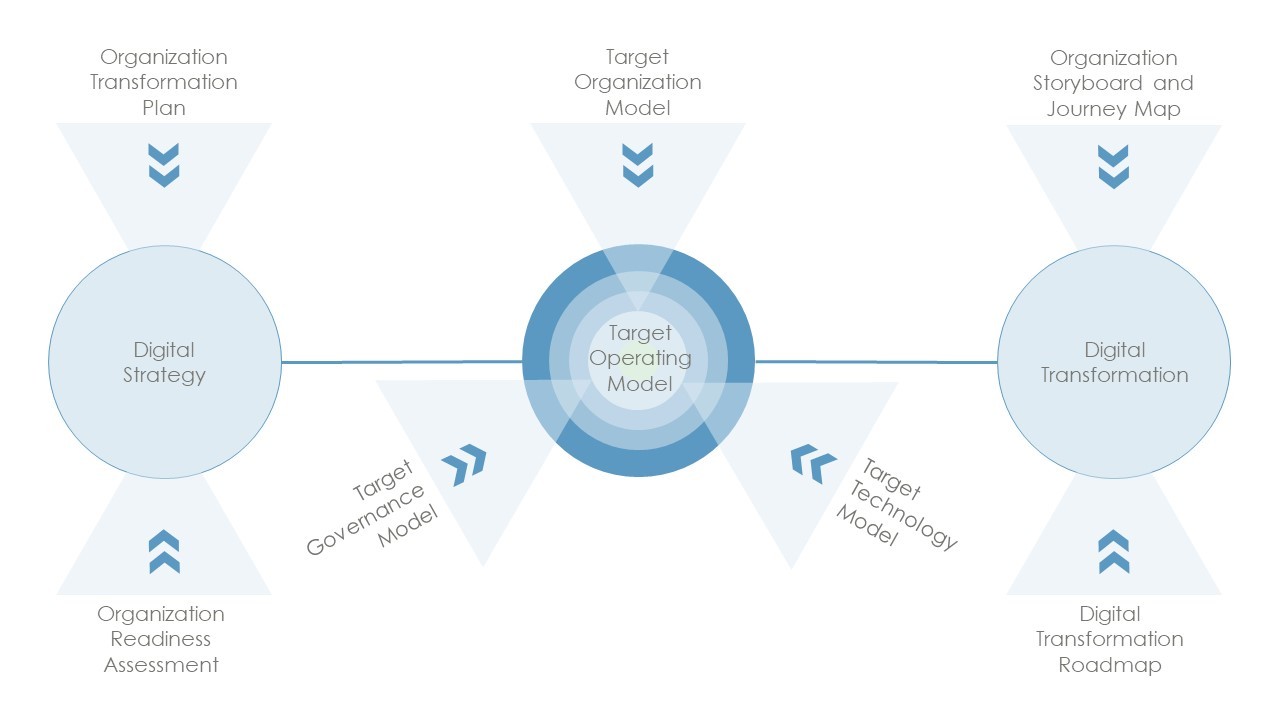
Interested in Digitally Transforming your Business? Start Here.
Director, Strategy & Consulting
If you are overwhelmed by constantly putting out fires in your day-to-day job, the concept of Digital Transformation may seem both idealistic and unattainable. But it does not need to be that way – a simplistic overview can get you both better informed and motivated to begin the journey toward your organization’s optimal, digital future state (after that fourth cup of coffee, of course).
Digital transformation is the process of introducing new and/or replacing legacy technology to enable minor enhancements, moderate improvements, or major changes to an organization’s existing business operating model. Many companies want to transform digitally but might not fully understand what a digital transformation entails or how to even get started.
The figure below shows a simplistic overview of the digital transformation process.

The circle on the left can be considered the “planning” stage; the circle in the middle the “designing” stage; and the circle on the right the “executing” stage (with the various triangles being the inputs into each stage).
Let us discuss each stage in more detail:
Planning Stage: An Introspective Discovery
Just as before starting any type of long-term strategic initiative, a business must first determine and document its reasons for undertaking said initiative. This includes the plan for how the organization will be transformed, the organization’s readiness for transformation, and a method for tracking the expected benefits from the change efforts.
Digital Strategy encompasses the three pillars of people, process, and technology. Company personnel must buy into the transformation and its expected changes for it to succeed. The identification of organizational transformation objectives and key results (OKRs) should be introduced to measure the effectiveness of the resulting efforts. And ultimately, the organization must be assessed for readiness – from both an internal capability perspective and a technology perspective, especially if new technologies such as artificial intelligence or machine learning will be included in the digital transformation.
The culmination of Digital Strategy is the Organization Transformation Plan considering current technical and functional capabilities, existing systems and software architecture, and the planned digital transformation OKRs (identified during the Organization Readiness Assessment).
After the organization has identified what it is capable of today, it must design what it wants to accomplish tomorrow. The next step involves determining its Target Operating Model: a framework comprised of an Organization Model, Governance Model, and Technology Model – all of which must be designed considering the strengths and weaknesses uncovered during the Digital Strategy stage.
Designing Stage: A Theoretical Ideal
An Organization Model indicates how activities such as task allocation, inter-communication and coordination, and reporting relationships are performed so that the business can collectively achieve its goals and objectives. A good Organization Model is logical, simple, and flexible to help the business achieve a sustainable competitive advantage. The best Organization Model will vary by company and can range from basic functional models utilizing a management hierarchy to a holacracy organization where decision-making is distributed to self-organizing teams.
A Governance Model incorporates robust and complete documentation that identifies, defines, and details the structure, processes, and technology required for a business to best compete in its market. Good governance documentation encompasses the entire project life cycle, is nested within a defined hierarchy and contains the appropriate range and depth of information for personnel to understand its requirements.
A Technology Model graphically indicates how systems and software are utilized to execute the business’s processes efficiently and effectively. The Technology Model should align with both the Organization Model and Governance Model to provide a visual picture of the complete business’s operating model (people, process, and technology). Careful consideration must be given to eliminating any digital gaps, process inefficiencies, and overly complicated communication networks to allow the business to work smarter and faster, at the least cost.
After the organization has designed how it wants to look tomorrow, the final step is to detail how to get the organization to its optimal future target state.
Executing Stage: How to Get It Done
Digital Transformation includes acting on the information discovered during the Planning and Designing stages. Digital Transformation should include an Organization Storyboard and Journey Map, and a Digital Transformation Roadmap.
An Organization Storyboard and Journey Map is a visual demonstration of the organizational changes that will be undertaken by the business during the digital transformation. This includes qualitative information, aligned with a high-level timeline so that personnel better understand what will be expected of them and what the organization will look like both during the transition and after the transformation.
The Digital Transformation Roadmap is a visual demonstration of the governance and technology changes that will be undertaken by the business during the digital transformation. This information will also be aligned with a high-level timeline so that personnel will better understand when new governance materials and technology systems and software will be developed and implemented, and what will be expected of them during the transformation.
Digital Transformation is a multi-year journey and just like all time-intensive initiatives, is at higher risk for failure. By better understanding the major steps and expectations, businesses can be better prepared to handle the challenges along the way.
Want to make sure you have a solid understanding of what’s needed for proper digital transformation? Check out our “Digital Transformation for Leaders” Colonnade course.
Author Bio
 John Jobst, Director of Strategy & Consulting, leads the operations strategy and management consulting service line for Enstoa’s global clients. A global architecture-engineering-construction leader with over 20 years of experience, John guides executive teams toward transformation of their legacy projects and portfolios by helping them design a target operating model and transformation roadmap for today’s digital world.
John Jobst, Director of Strategy & Consulting, leads the operations strategy and management consulting service line for Enstoa’s global clients. A global architecture-engineering-construction leader with over 20 years of experience, John guides executive teams toward transformation of their legacy projects and portfolios by helping them design a target operating model and transformation roadmap for today’s digital world.
If you are overwhelmed by constantly putting out fires in your day-to-day job, the concept of Digital Transformation may seem both idealistic and unattainable. But it does not need to be that way – a simplistic overview can get you both better informed and motivated to begin the journey toward your organization’s optimal, digital future state (after that fourth cup of coffee, of course).
Digital transformation is the process of introducing new and/or replacing legacy technology to enable minor enhancements, moderate improvements, or major changes to an organization’s existing business operating model. Many companies want to transform digitally but might not fully understand what a digital transformation entails or how to even get started.
The figure below shows a simplistic overview of the digital transformation process.

The circle on the left can be considered the “planning” stage; the circle in the middle the “designing” stage; and the circle on the right the “executing” stage (with the various triangles being the inputs into each stage).
Let us discuss each stage in more detail:
Planning Stage: An Introspective Discovery
Just as before starting any type of long-term strategic initiative, a business must first determine and document its reasons for undertaking said initiative. This includes the plan for how the organization will be transformed, the organization’s readiness for transformation, and a method for tracking the expected benefits from the change efforts.
Digital Strategy encompasses the three pillars of people, process, and technology. Company personnel must buy into the transformation and its expected changes for it to succeed. The identification of organizational transformation objectives and key results (OKRs) should be introduced to measure the effectiveness of the resulting efforts. And ultimately, the organization must be assessed for readiness – from both an internal capability perspective and a technology perspective, especially if new technologies such as artificial intelligence or machine learning will be included in the digital transformation.
The culmination of Digital Strategy is the Organization Transformation Plan considering current technical and functional capabilities, existing systems and software architecture, and the planned digital transformation OKRs (identified during the Organization Readiness Assessment).
After the organization has identified what it is capable of today, it must design what it wants to accomplish tomorrow. The next step involves determining its Target Operating Model: a framework comprised of an Organization Model, Governance Model, and Technology Model – all of which must be designed considering the strengths and weaknesses uncovered during the Digital Strategy stage.
Designing Stage: A Theoretical Ideal
An Organization Model indicates how activities such as task allocation, inter-communication and coordination, and reporting relationships are performed so that the business can collectively achieve its goals and objectives. A good Organization Model is logical, simple, and flexible to help the business achieve a sustainable competitive advantage. The best Organization Model will vary by company and can range from basic functional models utilizing a management hierarchy to a holacracy organization where decision-making is distributed to self-organizing teams.
A Governance Model incorporates robust and complete documentation that identifies, defines, and details the structure, processes, and technology required for a business to best compete in its market. Good governance documentation encompasses the entire project life cycle, is nested within a defined hierarchy and contains the appropriate range and depth of information for personnel to understand its requirements.
A Technology Model graphically indicates how systems and software are utilized to execute the business’s processes efficiently and effectively. The Technology Model should align with both the Organization Model and Governance Model to provide a visual picture of the complete business’s operating model (people, process, and technology). Careful consideration must be given to eliminating any digital gaps, process inefficiencies, and overly complicated communication networks to allow the business to work smarter and faster, at the least cost.
After the organization has designed how it wants to look tomorrow, the final step is to detail how to get the organization to its optimal future target state.
Executing Stage: How to Get It Done
Digital Transformation includes acting on the information discovered during the Planning and Designing stages. Digital Transformation should include an Organization Storyboard and Journey Map, and a Digital Transformation Roadmap.
An Organization Storyboard and Journey Map is a visual demonstration of the organizational changes that will be undertaken by the business during the digital transformation. This includes qualitative information, aligned with a high-level timeline so that personnel better understand what will be expected of them and what the organization will look like both during the transition and after the transformation.
The Digital Transformation Roadmap is a visual demonstration of the governance and technology changes that will be undertaken by the business during the digital transformation. This information will also be aligned with a high-level timeline so that personnel will better understand when new governance materials and technology systems and software will be developed and implemented, and what will be expected of them during the transformation.
Digital Transformation is a multi-year journey and just like all time-intensive initiatives, is at higher risk for failure. By better understanding the major steps and expectations, businesses can be better prepared to handle the challenges along the way.
Want to make sure you have a solid understanding of what’s needed for proper digital transformation? Check out our “Digital Transformation for Leaders” Colonnade course.
Author Bio
 John Jobst, Director of Strategy & Consulting, leads the operations strategy and management consulting service line for Enstoa’s global clients. A global architecture-engineering-construction leader with over 20 years of experience, John guides executive teams toward transformation of their legacy projects and portfolios by helping them design a target operating model and transformation roadmap for today’s digital world.
John Jobst, Director of Strategy & Consulting, leads the operations strategy and management consulting service line for Enstoa’s global clients. A global architecture-engineering-construction leader with over 20 years of experience, John guides executive teams toward transformation of their legacy projects and portfolios by helping them design a target operating model and transformation roadmap for today’s digital world.




